A Brief History of Table Etiquette
Welcome to one of the most misunderstood social rituals of contemporary times. Table and Dining Etiquette. A ritual steeped in Western customs and culture and yes, a ritual the majority of us take part in each and every day but only have a minimum understanding of the rules of table and dining etiquette. Eating! Most of us have some basic understanding of how to dine requiring the use of metal utensils and go through the motion as though we know exactly what we are doing is correct dining etiquette. This is true because most of us enjoy dining at venues with ambiance and great service, as oppose to a casual diner where we are eating with our hands and out of a bag or a box.
The art of fine dining may appear on the surface to be complicated but it is far from that. In fact, it is rather straight-forward. To simply this rather wonderful, civilizing system of “consuming a meal” exercise, I think it’s so important to keep this civilizing ritual alive simply because it is an essential social discipline that is recognized and honored by an overwhelming majority of societies around the world, be they European, Asians, Africans and North and South Americans. 85% of the world are proficient in European Table and Dining Etiquette.
From this perspective, I would like to start by acknowledging the language of English and the customs and culture we have (as Americans), inherited from England in particular and from other great European societies in general. We owe a great deal to our French brothers and sisters, who have contributed so much to our rich infusion of the French language, cuisines and wines. We also owe the French for their wonderful dining terms such as; sorbet or a la carte or Hors d’ oeuvre, etc., etc. Even the word etiquette has its roots in French culture.
For parents, who want their child or children to realize their fullest potential, would translate into one simple reality; an education in etiquette is absolutely essential! One of our most respected statesman of the 19th and 20th Century made the following pronouncement in his book “Golden Manual or the Royal Road to Success.”
No person’s education is complete without a thorough knowledge of the rules of etiquette.
Written by Henry Davenport Northrop and published in 1882 is a wonderful critique of the social values of that period and how applicable those values are today with few exceptions. After all, our heritage is our inheritance! If parents truly want their children to be “educated” to succeed, they must realize the world is global and your child will have to be prepared to be a global citizen if you want to properly prepared to be all they can be.
European customs and culture, especially table and dining etiquette are the standards, regardless of where your child is having a business lunch or dinner. Be it in Dubai, Hong Kong or New York, the rituals of European dining are fundamentally the same the world over. Therefore, having impeccable dining manners should be considered an absolute necessity and the reasoning is simple; a culturally well-rounded child/adult will go far and wide regardless of their career choice.
I would like to start educating my readers in the socially defining ritual with one fundamental truth. “If you want to understand any social/cultural discipline, you will first have to learn the “rules” of how the “discipline” is designed to function, be it Chess, Golf, Basketball or Dining Etiquette.” If you do not know the rules governing a given discipline, you will not understand what to do or why it should be done a certain way. Nor will you understand the reasoning and logic behind what is being done, in the manner, it should be done! Intellectualizing any discipline is truly empowering. If you can devote time to learning the rules of basketball, you can certainly devote the time to learn the game and the rules of fine dining!

With more than 20 years of educating children and adults in the finer nuances of European Dining. The decision to start an etiquette company has given me an accelerated appreciation of the social graces in general and the art of dining with grace and poise in particular. It’s much like Michael Jorden driving to the basket to execute a reverse layup as he avoids two defensive players and score, wow.
Dining etiquette is no different when learned and practiced the same as any game of sports or learning to play a musical instrument. Both are “intellectual” endeavors with one requiring specialized full-body engagement and the other requiring only the use of your hands and upper torso. One is observing a highly talented athlete who has invested dozens of years in perfecting their skill and for those who are aware of the social and professional value in having this universal dining skill will have significant social and professional advantages in their career goals and objectives.
Dining etiquette is no different than learning to perfect any skilled discipline. In order to understand the rules governing formal dining, will require a very brief overview of its history. Formal dining and its rituals are one of the many social refinements in Western customs and culture dating back more than a thousand years in European history with England and France being its primary historical contributors to our treatment of the subject in this writing. We must again, acknowledge the French for certain adaptations, especially for adding French words to our “English” vocabulary such as the word “etiquette.”
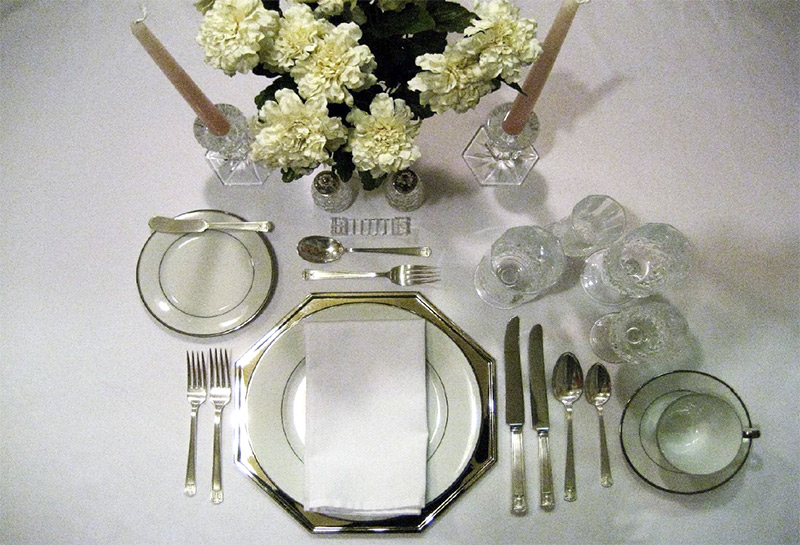
Dining in general and formal dining, in particular, are systems made up of rules covering two basic disciplines. First is, Table Etiquette. A discipline that represents the “logic and reasoning” of why the table is set in a particular arrangement for each diner. Secondly, is being able to identify all of the items placed on the table and why they were selected for this particular lunch and dinner event. And thirdly, dining manners (the rituals of artfully using specific utensils with grace and poise to consume each course) or on occasions, may be referred to as Dining Etiquette.
The Rules Governing Table Etiquette
European customs in table setting are the same in principle, be it informal or formal. It is important to learn to visually identify all items by name so that you will be able to know a “fish fork” from a “salad fork” when you see it. Table etiquette items consist of; table cloth and napkins; China or porcelain/earthenware; flatware or eating utensils commonly called silverware, and lastly; stemware or more commonly called, drinking glasses. Note: adding center arrangements such as flowers is part of table adornment and is done to make the table more attractive and inviting to your guest.
Table Etiquette involves all of the basic items used to set a table for lunch or dinner, informal or formal. The rules involved in placing China and associated utensils on the table are fundamentally the same except for two minor exceptions, where the napkin is placed to signal a formal table setting, secondly, by the number of courses on the menu and thirdly, the order in which each course will be served. In this critique, I will provide examples of a four or five-course formal lunch or dinner to highlight these minor differences. It’s important to know the rules governing how to identify every item placed on the table and why they are placed in that particular position.
Starting with the China. I will identify each item based on its “size.” In other words, the dinner plate is the largest plate used to place one or more food items on at a table setting. Based on size, the next smaller plate is the luncheon plate and smaller in size is the salad plate. Smaller than the salad plate is the bread and butter plate. There is a larger plate that may be used on occasions and it is called a service plate. There is a Charger plate that serves as a “decorative support” plate for the dinner plate to be placed on top. Its primary purpose is to add a touch of attractiveness to the table. The last items to complete an informal or formal table setting is a tea (or coffee) cup (with a “foot” for a formal lunch or dinner) and saucer.
To be proficient in Table Etiquette, you will not only have to identify all China or porcelain items to a complete table setting. You will also have to identify all supporting service items. Those items include a cream and sugar bowl, a main oval service plate and covered service bowl, a tea and or coffee server i.e., a coffee pot, and two or more sets of salt and pepper shakers.
Now that we have the China out of the way, the other challenge is learning all of the primary dining utensils. Flatware or silverware is perhaps the most complicated aspect of Table Etiquette. The reason it is complicated has a great deal to do with their numerous sizes and shapes. The logic behind this variation has everything to do with what food item is being consumed! Therefore, a standard 5-course dinner menu (European customs) may consist of an Appetizer, Soup, Entrée, Salad, and Dessert. It is customary when the table is set European style, to serve the salad after the main Entrée so as to cleanse the diner’s palate before consuming dessert.

The relationship between the menu and the number of utensils, their design and purpose are all connected, even how they are used to dine are all related. I say this because a regular 4 or 5-course formal dinner may comprise of 8 to 11 utensils or on occasions, 12 utensils that are individually designed to be used for each specific course. Yes, utensils designed to consume a particular course. So allow me to start by providing the appropriate name to call utensils for consuming a particular course. The title most of us use to identify eating utensils has as much to do with class and or education than anything else. If you prefer calling utensils silverware, it would be wise to understand why that term is commonly used and the distinction concerning such usage.
The usage of the word “silver” has more to do with the metal used to manufacture the utensil. The word silver implies that the metal used is “silver” but the metal may be “steel” or “stainless steel” and consist of no “silver” metal at all. Now the person that is educated would immediately know that you are unaware of the difference. Remember, class and affluent social customs are still alive and well in contemporary American society.
So now that we know that dining terminology is a clear indicator of your aspirations in life, as in being proficient in having impeccable dining manners does matter to you, the same as it does within certain social and professional cycles. Regarding usage, especially when identifying table utensils is important. The term “silver” is use when the diner is uncertain the utensils are indeed silver! It’s quite okay to use the term silver if you are certain the utensil is plated silver or sterling. For a utensil to be properly class as “silver” the metal content must meet the international standard to be judged “silver.” For that to be the case, the utensil would be marked with the word “sterling” on the back side of the utensil. If the term “plated” is used, then the utensil has a coat of silver on top of a base metal to “appear” to be sterling silver. The reason plated utensils were and are a popular choice, was the cost. The cost of a set of plated flatware for eight would be less than a fourth of the cost for a sterling silver set for eight. To be classified as sterling, the minimum silver content would be 70% pure silver. Translation; $500.00 to $700.00 for a plated set for eight” (2 or 3 ply plated silverware) versus a set for eight in sterling would range in the $2,500.00 to $3,500.00 price range or higher.
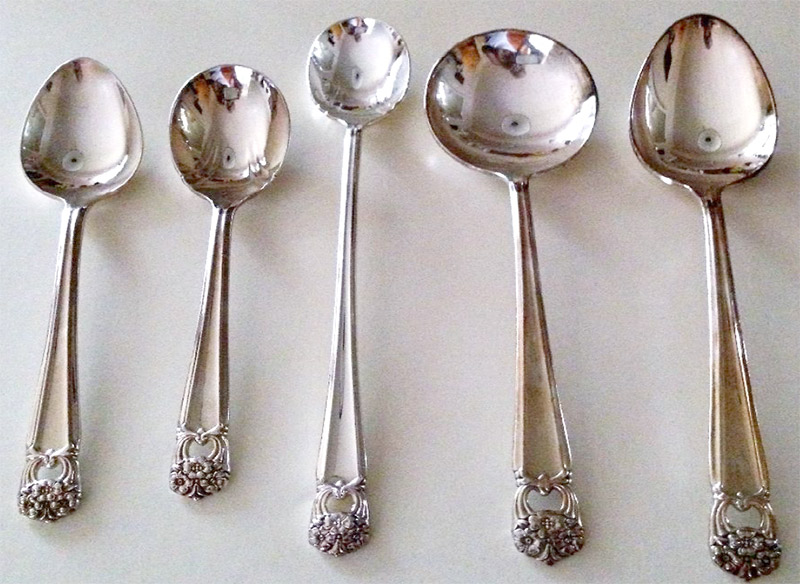
One of the more interesting questions I am often asked about flatware is, how can I distinguish the difference in plated flatware from the more expensive sterling flatware? For this question to be answered, I start by stating; there is no absolute rule-of-thumb, without close examination of a utensil. You can determine the metal content by looking on the back of a utensil and you will see identification marks, indicating if its “stainless,” “plated” or “Sterling.” If you have been invited to a formal dinner party, you should not (out of curiosity) turn one of the utensils over to see its markings nor bring up the subject at the dinner party. It’s simply not the kind of question you should ask! However, if you are interested, there are some clues that will help in making a well-educated guess. It’s all about “color,” be it stainless steel, plated silver or Sterling silver. You can be certain about one thing, and that is very obvious, the color. If the color of the utensils looks to be more in the yellow spectrum than in the blue silver spectrum, then you know the utensils are either “plated silver” or sterling silver. Another clear indicator would be the color of the “blade” of the knife(s). If the blade is a different color (bluest) than the handle, would be a clear indicator of the utensils being either plated silver or sterling silver at the table. If the utensils are stainless steel, they will have a gray-blue tone on the blade and handle of the knife.
The drawback in buying stainless steel flatware is the “limited” number of specialized utensils most manufacturers of stainless steel flatware offer in each pattern. They may look very attractive but in most cases, has its limitations. In other words, if you wanted to purchase butter spreaders or dessert spoons/forks in the same pattern, would in most cases, not be available. To avoid this issue, check with the manufacturer to see what extra utensils are available for this particular pattern before you make a purchase. A butter spreader is essential if your China has a bread and butter plate. If your goal is to have a complete set of flatware, you will be limited to purchasing a quality plated set or a sterling silver set. Most of your major manufacturers of sterling silver flatware produce all of the items required for a complete formal set. My personal favorite sterling manufacturer is Reed and Barton.
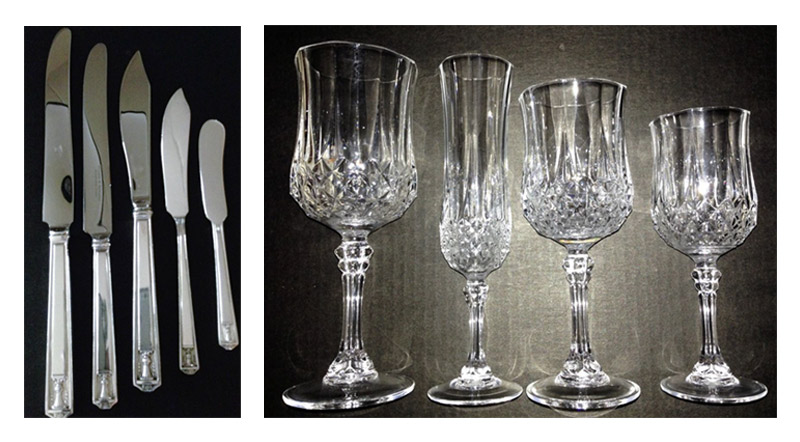
For your information, there are more than 57 individual utensils to a complete set of flatware and therefore, I will not devote time and space in this article to name all 58 pieces. I will, however, identify utensils that would constitute a basic set for a formal 4-course dinner. This, of course, can vary as it relates to the selection of food items selected for the dinner. I will name the utensils required for a four-course lunch or dinner with salad being the first course. Starting from left to right of the dinner plate you have, the salad fork, next is the dinner fork. On the right side of the dinner plate is the dinner knife, next to it is the salad knife (blades facing left towards the dinner plate), next is the soup spoon (regular soup spoon or cream soup spoon) and lastly is the teaspoon. Your dessert utensils are placed at the top center of the dinner plate. Your dessert utensil(s) can comprise of one dessert fork or one dessert spoon. There may be on occasions, two dessert utensils at a setting, a dessert fork (tines facing right) and a dessert spoon placed above the dessert fork with the bowl of the spoon facing left. Both utensils are placed above the dinner plate. The rule governing how dessert utensils are placed directly above the dinner plate, relates to the left and or right-hand usage. A dessert fork is to be in the “left hand” and never in the “right hand.” The same rule applies when using the dessert spoon. The dessert spoon is to never be used by the left hand. All knives and spoon are to be used by the right-hand; and likewise, all forks are to remain in the left-hand and never switched to the right hand while dining European style.
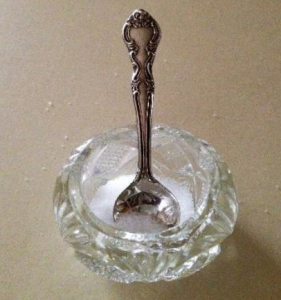 The reason for providing your dinner guest with “two” dessert utensils, is done so that they may “choose” what utensil they prefer to use in consuming their dessert. If they select a fork to consume their dessert, they would eat their dessert with their left hand. If they decide to use their spoon, they would eat their dessert with their right hand. Lastly, is the individual butter spreader. The butter spreader is placed paralleled across the top of the bread plate with the blade facing downward. Reasoning? The butter spreader is a knife and should be in the right hand the same as all knifes when dining European style. The number of utensils for a formal four-course dinner would be eight or nine utensils per place setting.
The reason for providing your dinner guest with “two” dessert utensils, is done so that they may “choose” what utensil they prefer to use in consuming their dessert. If they select a fork to consume their dessert, they would eat their dessert with their left hand. If they decide to use their spoon, they would eat their dessert with their right hand. Lastly, is the individual butter spreader. The butter spreader is placed paralleled across the top of the bread plate with the blade facing downward. Reasoning? The butter spreader is a knife and should be in the right hand the same as all knifes when dining European style. The number of utensils for a formal four-course dinner would be eight or nine utensils per place setting.
My next brief overview on the Art of Table and Dining Etiquette will cover the rules of dining both European and American style dining with poise and grace. I consider the Art of Fine Dining to be the most socially enriching experience all determine individuals can master. It is one of the few social rituals indulged in each and every day of your life!! The rules governing European Dining Etiquette is one of the social/cultural delights, practice all over the world. It is a wonderful way to express adherence to a great tradition and a wonderful way to celebrate our social customs and value system!!
Written by: Nathan Wright, Civility Maven and Historian


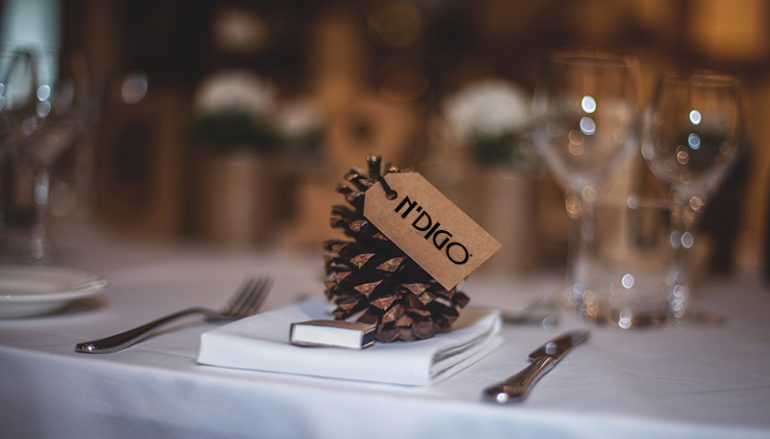




nice article
Thank you, more to come on the art of fine dining.